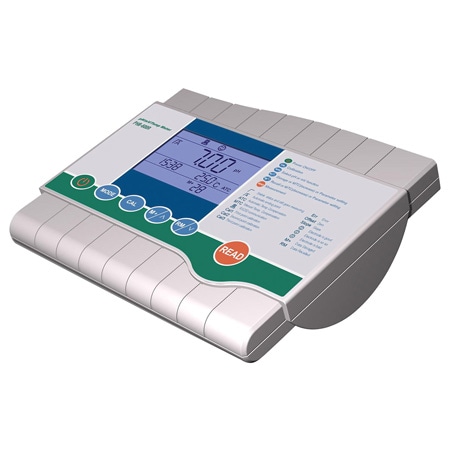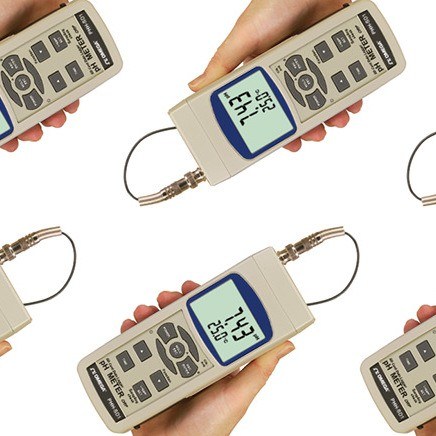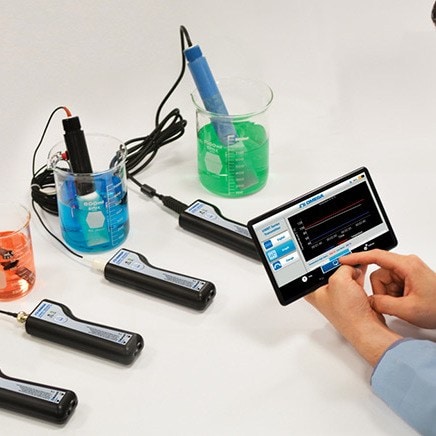This article is designed to apply, in general, to all specific ion electrodes. Typically, the ISE (Ion Selective Electrode) that is purchased will come with its own instruction manual that pertains to that particular type of electrode. It is best to read all instructions thoroughly before using the electrode. When the ISE is received, it is advised that you open up the package immediately and check all the parts of the electrode. Most ISE's have a pre-treatment procedure that should be followed prior to operation.
Before beginning your measurements the following are a few basic facts that will aid in designing your analysis procedure.
Agitation
When carrying out selective ion measurements, it is important to have good agitation. This allows a fresh supply of ions to be exposed to the sensing portion of the ISE. It is best to select a speed that keeps a constant, smooth motion. A turbulent rate should be avoided.
Sample pH
Most ISE's require a specific pH range for optimum performance of the electrode. Some ISE's require a precise adjustment. Consult OMEGA's pH Engineering staff for details on purchasing a pH adjustment reagent formulated for your particular electrode.
Response Time
ISE's require a much longer time for the readings to stabilize. At least fifteen minutes should be allowed for equilibrium to be established when measuring your standard solutions.
Establishing a Calibration Curve
It is recommended to use three standard solutions when establishing a calibration curve. To choose the concentrations of the standard solutions it is helpful to know the approximate values of your unknown solutions. For example, if your unknown solutions are in the 100 ppm range, the choice of standards may include a 10 ppm, a 100 ppm, and a 1000 ppm solution.
Rinsing
It is necessary to rinse the ISE between measurements to insure accurate readings. Use a steady stream of deionized or distilled water. Take care not to rub the electrode with a cloth to dry the probe. It is usually best to "shake off" any excess water. Take care not to hit the probe against anything while shaking the electrode.
Conditioning
The ISE needs to remain moist at all times even when not in use. Consult the operator's manual that accompanies your electrode for details on cleaning, conditioning and storing the ISE. Common Questions and Answers About Ion-Selective Electrodes
What is an Ion-Selective Electrode?
An Ion Selective Electrode measures the potential of a specific ion in solution. (The pH electrode is an ISE for the Hydrogen ion.) This potential is measured against a stable reference electrode of constant potential. The potential difference between the two electrodes will depend upon the activity of the specific ion in solution. This activity is related to the concentration of that specific ion, therefore allowing the end-user to make an analytical measurement of that specific ion. Several ISE's have been developed for a variety of different ions.
What Type of Equipment is Needed for an ISE Measurement?
A pH meter that also measures millivolts can be used to interface with an ISE. Most ISE's are combination electrodes that have the reference electrode built into the body of the ISE, however, some ISE's require a separate reference electrode. If this is the case, the pH/mV meter must have a pin-connector to connect the reference electrode.
How Does the mV Reading Correspond to the Concentration?
Standard solutions of known concentrations must be accurately prepared. These solutions are then measured with the pH/mV meter. The mV reading of each solution is noted and a graph of concentration vs. mV reading must be plotted. Now the unknown solution can be measured. The mV value of the unknown solution is then located on the graph and the corresponding solution concentration is determined. Please see the graph shown above as an example.
What is Ionic Activity?
Ionic activity is a thermodynamic measurement that represents the energy available due to free and reactive ions in solution. The activity coefficient is the ratio between the free ions and the total ionic concentration in the solution.
Why is pH Adjustment Necessary?
I n many cases pH control is necessary for accurate, repeatable measurements. Certain ions exhibit different activity when different concentrations of hydrogen ions are present in solution. This occurrence will not only alter the potential due to the specific ion that is measured, it may also allow other ions in solution to become active that otherwise were not. This increased activity from the other ions will interfere with the ability to evaluate the ion of interest.


